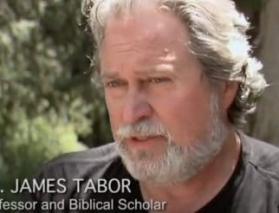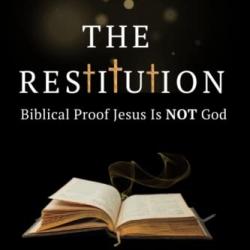My favorite biblical study is Son of Man Study. First of all, it is because Jesus identified himself often as “the son of man.” In my book The Gospel (a single narrative harmony of the four New Testament gospels that is in my book The Gospels Interwoven), I have Jesus referring to himself 38 times as “the son of man.” In contrast, he never actually identifies himself expressly as “the messiah” until the end, when he answers positively Caiphas’ question before the Sanhedrin as to whether or not he is the Messiah.
Another reason why I most favor Son of Man Study is that I think the most important text in the Bible, except perhaps the Shema in Deuteronomy 6.4-5, is Daniel 7.13-14. Daniel states, in the NIV, “In my vision at night I looked, and there before me was one like a son of man, coming with the clouds of heaven. He approached the Ancient of Days and was let into his presence. He was given authority, glory and sovereign power, all peoples, nations and men of every language worshiped him. His dominion is an everlasting dominion that will not pass away, and his kingdom is one that will never be destroyed.” The expression “Ancient of Days” is mentioned three times in Daniel 7; it is the only place in the Bible where it is mentioned; and it obviously refers to God, whom Jesus repeatedly called “Father.” It is interesting that this occurrence of “one like a son of man” only appears here in the entire Jewish Bible (=Old Testament).
In my book, The Restitution of Jesus Christ, I have a large section on the figure “one like a son of man” in Daniel 7.13. Therein, I address the three major interpretations of this figure: (1) it refers exclusively to Jesus, as church fathers believed; (2) it refers to some unidentified angel; (3) it does not refer to an individual being but is a metaphor referring to the Jewish saints mentioned later and repeatedly in Daniel 7. I embrace (1) and thus reject the other two interpretations. Yet in modern times, these last two interpretations, especially (3), called “the Jewish saints interpretation,” have been advocated by the majority of distinguished Old Testament scholars.
In my RJC book, I assert that the Jewish saints interpretation of “one like a son of man” in Daniel 7.13-14 is incorrect because “the saints” or “the holy ones” (Aramaic kedoshi), who are mentioned later in this chapter and associated with “the Most High” (“the saints of the Most High” in vv. 18, 22, 25, 27; “saints” only in v. 21) are “all peoples, nations and men of every language” in v. 14. Thus, faithful Jews in particular are not the focus of Daniel 7; they are only included among the saints. Thus, the saints represent a much larger entity than faithful Israel, being comprised of all believers throughout the earth.
This is the kingdom Jesus taught so much about it. I think he derived his idea of the kingdom of God/heaven primarily from Daniel 7.14 just as he derived his primary means of self-identification as the son of man from v. 13. And Jesus seems to have had in mind Daniel 7.13-14 when he taught his parable about “a nobleman” who “went to a distant country to get royal power for himself and then return” (Luke 19.11 NRSV). Some versions translate “a kingdom” instead of “royal power.”
Incidentally, most English versions translate elyonin in the Aramaic text of Daniel 7 (vv. 18, 22, 25, 27) as “Most High.” This is complicated, so put on your thinking cap. In each of these four instances, elyonin is associated with “the saints.” But both illaya and elonin appear together in v. 25, with illaya appearing first and obviously referring to God as the Ancient of Days. It says the little horn, which I think symbolizes the Antichrist of the latter days, “will speak words against the Most High” (v. 25). That this illaya refers to God is later affirmed in Dan 11.36 which says of this Antichrist that he “shall speak horrendous things against the God of gods,” which surely refers to the Ancient of Days in Daniel 7. But the NRSV and ESV translate both illaya and elyonin in v. 25 as “the Most High,” seemingly referring to the same person, thus God. I think this is incorrect. Rather, in all four instances in Daniel 7 in which elyonin appears, “the saints” belonging to him identifies those people of his kingdom mentioned in Daniel 7.14, so that elyonin in each occurrence in Daniel 7 refers to “one like a son of man.” Thus, in v. 25, illaya refers to God, and elyonin refers to the son of man, who I believe is Jesus.
Accordingly, elyonin in Daniel 7.25 should not be translated “Most High,” as in the NRSV and ESV, since it causes confusion with the previous “Most High” in this verse. Rather, the NASB translates it best in the four occurrences of elyonin in Daniel 7 as “the Highest One.” Jesus therefore is the Highest One of all men and angels, sitting with God on his throne as the New Testament repeatedly states as a fulfillment of Ps 110.1. And here in Daniel 7.13, he is brought up to God’s throne as the highest place in heaven.
To make things even more complicated, I think a case can be made for each of the four instances of elyonin in Daniel 7 referring to both God and this son of man since elyonin is a plural word. Moreover, the New Testament repeatedly states that this kingdom to which the son of man is given in v. 14 still belongs to both God and Jesus.
But why did Jesus so often identify himself as “the son of man,” thus without the word “like,” if he derived this concept from Daniel 7.13, which is about “one like a son of man”? It seems at some point in time this expression was shortened to “the son of man.” This is reflected in The Book of Parables (=Similitudes) in 1 Enoch, thus 1 Enoch 37-71. Non-canonical 1 Enoch consists of multiple parts written at different times during the first and second centuries BCE. This portion of 1 Enoch should be considered in Son of Man Study. Then, why was the word “like” (Aramaic ke) included in this expression. I think it indicates Jesus’ Virgin Birth. (See also Revelation 1.13 and 14.14, in which the article is not in the Greek text, so that it can be translated “one like a son of man.”)
Many modern scholars reject that Daniel’s “one like a son of man” refers to Jesus since Daniel 7 does not depict this figure as coming to earth or, more importantly, as suffering and dying. As for coming to earth, I believe the context of this prophetic scene in Daniel 7.13-14 indicates an actual royal ceremony that will occur in heaven right before the second coming of Jesus Christ with his glorious kingdom. Although Daniel does not say this figure comes down to earth with his kingdom after being given it in Daniel 7.13-14, it is necessarily implied because all that is said about it in the remainder of Daniel 7 indicates as much. That is, this kingdom takes the place of the previous, destroyed kingdoms (vv. 11-12), the saints possess this kingdom on earth (v. 22), and this kingdom is “everlasting” (v. 27).
And as for Daniel 7 not saying this “one like a son of man” will experience suffering and death, this also is implied since so many of these saints in Daniel 7 are persecuted and suffer martyrdom in the endtimes. Jesus taught that the disciple is not greater than his or her master. Thus, the master, “the one like a son of man,” must become the model for his people, the saints. That is what the innocent Jesus did when he was persecuted by especially the religious officials in Jerusalem and thereafter suffered the shame and horrid violence of death on a cross, even feeling abandoned by his God, all of which is arguably the greatest suffering anyone can endure.
…………….
To see a list of titles of 130+ posts (2-3 pages) that are about Jesus not being God in the Bible, with a few about God not being a Trinity, at Kermit Zarley Blog click “Chistology” in the header bar. Most are condensations of my book, The Restitution of Jesus Christ. See my website servetustheevangelical.com, which is all about this book, with reviews, etc. Learn about my books and purchase them at kermitzarley.com. I was a Trinitarian for 22 years before reading myself out of it in the Bible.















